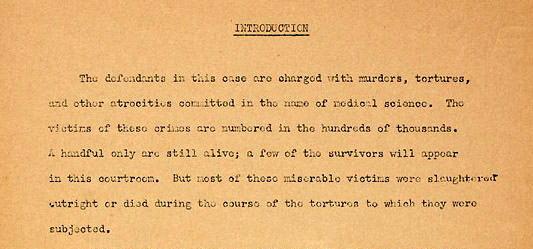
Introduction to the Nuremberg Trials
In the introduction, written by Karen Phinney and edited by Katie Jo Parris, you will find background information of the Nuremberg Trials, those involved, and a brief description of the crimes and convictions. The main sources used were Calvocoressi's Nuremberg, the Facts, the Law and the Consequences, "War Crimes Tribunals; an In-Depth Analysis", and "The Avalon Project" at Yale Law School.
During the atrocities of the Second World War, the Allied powers, namely the United Kingdom, the United States of America, the Provisional Government of the French Republic, and the Union of Soviet Socialists, stated that there would be retribution of the Axis's war crimes, namely Germany's crimes against the Jews. At the conclusion of the war, the victors had several options of how to deal with the crimes of the German people. Aside from doing nothing, the Allied powers could hold a trial of neutral judges, hand all judgment over to the German people, or follow an executive action, as recommended by Winston Churchill, the Prime Minister of the United Kingdom (Calvocoressi 19). However, in order to lessen the collective guilt of the German population, the Allies chose to focus on the principle of individual responsibility through a trial. Thus the Nuremberg trials, established for the "just and prompt trials and punishment of the major war crimes" (The Avalon Project, article 1) were the major means of justice imposed on the Axis powers by the Allies.

On August 8, 1945 in London, the International Military Tribunal was signed by all of the Allies. This Tribunal consisted of thirty articles that illustrated the Constitution of the Tribunal through the Jurisdiction and General Principles, the Committee for the Investigation and Prosecution of Major War Crimes, the Fair Trials for Defendants, the Powers of Tribunal and Conduct of the Trial, the Judgment and Sentences, and the Expenses (The Avalon Project, article 1-30). The Tribunal also dictated the role the Allied governments would have in the judgment process. From each power there was to be four representatives along with one alternate of the same government. The alternate would attend all of the same meetings and hearings as the representatives and in case of illness or extraordinary circumstances would replace a representative of his government (Calvocoressi 17). Thus the trials were to be held with equal representation from the Allies; the victors of World War Two would decide the fate of the German perpetrators.
Aside from the active roles of the Tribunal, any government of the United Nations could adhere to the agreement and support the Allies. Nineteen individual governments chose to adopt the Allied standing, and help decide the Nuremberg trials; these governments included Norway, Denmark, Belgium, the Netherlands, Luxemburg, Czechoslovakia, Poland, Yugoslavia, Greece, Australia, New Zealand, India, Ethiopia, Panama, Honduras, Haiti, Paraguay, Uruguay, and Venezuela (Calvocoressi 16). Support for the Nuremberg trials was widespread; Justice was finally being imposed on those who chose to disregard it during the war.
In order to prosecute, the Tribunal divided the crimes into three sections: "Crimes against the Peace", "War Crimes", and "Crimes against Humanity" (The Avalon Project, article 6). A fourth crime was recognized as "Conspiracy to Commit Crimes Alleges in Other Accounts." Twenty four individuals who participated in the crimes of World War Two, who were thought to hold the most responsibility, were placed on trial and awaited judgment. Those people who were of high governmental standings and had great influence over the war crimes included Goering, Hess, Ribbentrop, Rosenberg, Frank, Frick, Funk, Schacht, Sauckee, von Papen, Seyss-Inquart, Speer, von Neurath, and Friche. Those prosecuted who had been in prominent state positions included Ley, Streicher, von Schriach, and Broman. Keitel, Donitz, Raeder, and Jodl represented the fighting services that were put on trial; Kaltenbrunner was tried as a member of the SS and the police; and Gustav Krupp was prosecuted for providing industry for the Nazi regime (Calvocoressi 61). By placing the guilt on individuals, the Tribunal was able to punish many of the crimes of World War Two.
Of the twenty-four men named, only twenty two were tried, all of whom pleaded not guilty (Controversies on File, par. 4). In regards to their crimes, none denied that the crimes had taken place. They instead stated that they were not responsible for such crimes. However as stated by the lead prosecutor, U.S. Supreme Court Justice Robert Jackson,
The wrongs which we seek to condemn and punish have been so calculated, so malignant and so devastating that civilization cannot tolerate their being ignored because it cannot survive their being repeated. (Controversies on File, par. 2)
Thus, after eleven months of trial, from November 20, 1945 to August 31, 1946 (Calvocoressi 10), eleven of the accused were sentenced to death, three were acquitted and the rest received prison terms (Controversies on File, par. 4). In November of 1946 ten men were hung; Herman Goering, like Hitler, committed suicide before he could receive his fatal punishment (Controversies on File, par. 4). Through the arrival of a decision by the Tribunal of judicial action those individuals directly held responsible for the Jewish genocide were punished for their wrongdoings. The punishment of these high ranking officials indirectly assigned guilt to the Axis powers successfully.